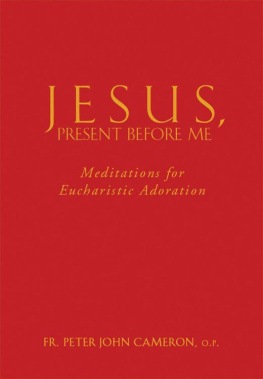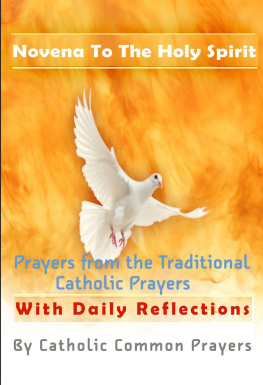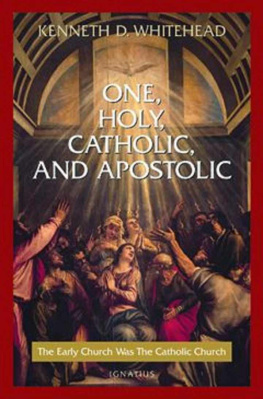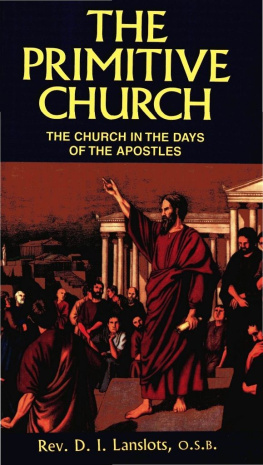NOVENAS
FOR THE CHURCH YEAR
Other Books by
Fr. Peter John Cameron, O.P.
The Classics of Catholic Spirituality
To Praise, To Bless, To Preach:
Spiritual Reflections on the Sunday Gospels, Cycle A
To Praise, To Bless, To Preach:
Spiritual Reflections on the Sunday Gospels, Cycle B
To Praise, To Bless, To Preach:
Spiritual Reflections on the Sunday Gospels, Cycle C
Jesus, Present Before Me:
Meditations for Eucharistic Adoration
Why Preach:
Encountering Christ in Gods Word
Mysteries of the Virgin Mary:
Living Our Ladys Graces
Blessing Prayers:
Devotions for Growing in Faith

Nihil Obstat
Msgr. Michael Heintz, Ph.D.
Censor Librorum
Imprimatur
 Kevin C. Rhoades
Kevin C. Rhoades
Bishop of Fort Wayne-South Bend
June 6, 2012
The Nihil Obstat and Imprimatur are official declarations that a book is free from doctrinal or moral error. It is not implied that those who have granted the Nihil Obstat and Imprimatur agree with the contents, opinions, or statements expressed.
Every reasonable effort has been made to determine copyright holders of excerpted materials and to secure permissions as needed. If any copyrighted materials have been inadvertently used in this work without proper credit being given in one form or another, please notify Our Sunday Visitor in writing so that future printings of this work may be corrected accordingly.
Copyright 2012 by Peter John Cameron, O.P. Published 2012.
17 16 15 14 13 12 1 2 3 4 5 6 7 8 9
All rights reserved. With the exception of short excerpts for critical reviews, no part of this work may be reproduced or transmitted in any form or by any means whatsoever without permission in writing from the publisher. Contact: Our Sunday Visitor Publishing Division, Our Sunday Visitor, Inc., 200 Noll Plaza, Huntington, IN 46750; 1-800-348-2440; .
ISBN: 978-1-61278-540-0 (Inventory No. T1240)
eISBN: 978-1-61278-287-4
LCCN: 2012948711
Cover design: Lindsey Riesen / Interior Design: Dianne Nelson
Cover art: Shutterstock
Printed in the United States of America
For Sister Marie Rita Syn of the Blessed Sacrament Benedictines of the Congregation of Jesus Crucified in honor of her Golden Jubilee of Religious Profession
Serve the Lord with joy.
Amen! Alleluia!
Table of Contents
Foreword
Numero deus impare gaudet. (God rejoices in the odd number.)
Virgil
The Church encourages the faithful to deepen their faith by taking advantage of all available means in harmony with the teachings of the Church. Especially venerable among these is the devotion known as the novena.
What Is a Novena?
The Directory on Popular Piety and the Liturgy says this about novenas:
Throughout the middle ages many forms of popular piety gradually emerged or developed. Many of these have been handed down to our times: nucleuses of sacred times based on popular practices were constituted. These were often marginal to the rhythm of the liturgical year: sacred or profane fair days, tridua, octaves, novenas, months devoted to particular popular devotions.
A novena is a prayer (or a series of prayers) said consecutively for nine days. The prayer which can be either private or public is recited daily as a preparation for a certain feast or in order to obtain some special favor.
The novena stands out as a spiritual exercise of hopeful yearning and expectation. It helps predispose the one who prays to receive the particular heavenly graces sought. At the same time, praying the same prayer nine days in a row builds up the confidence and gratitude of the believer through an experience of holy anticipation. As a prayer form, the novena incorporates two key qualities of efficacious prayer: trustful certainty and faith-filled perseverance.
St. Augustine points out that the deepest motive for prayer like the novena is the enlarging of desire:
Our Lord and God does not want to know what we want (for he cannot fail to know it) but wants us rather to exercise our desire through our prayers, so that we may be able to receive what he is preparing to give us. His gift is very great indeed, but our capacity is too small and limited to receive it. That is why we are told: Enlarge your desires.
The Nine of the Novena
According to a pious tradition, the concept of the novena finds its inspiration in the nine months during which the Christ-child was carried in the womb of his mother before Christmas. The Advent O Antiphons leading up to Christmas (December 17-23) have a novena-like quality about them (O Wisdom, O Adonai, O Root of Jesse, and so forth). The model and the first of all novenas was that prayerful awaiting undertaken by the apostles and the Blessed Virgin Mary in the Upper Room the Cenacle in the nine days between the Ascension of the Lord and Pentecost (see Acts 1:4, 13-14).
And yet our system of mathematics is decimal: it is based on the number ten as the symbol of the entire method of numeration. Some suggest that since the number ten represents a kind of perfect number, the number nine being just shy of ten is the number of imperfection. Praying from this position of nines imperfection is deemed altogether fitting for fallen, mortal creatures like us. St. Jerome contends that, since all the animals which Noah took into the ark by pairs were unclean, even numbers are iffy, and odd numbers denote cleanness.
He declared that the number nine is perfect, and is said to be more perfect because its form derives from the multiplication of the perfect triad. The Middle Ages saw an increase of interest in number symbolism and the spiritual significance of numbers, especially by several Cistercian numerologists.
A twelfth-century Spanish treatise on arithmetic known as Queritur, by an author called Johannes, highlights the prominence of the number nine. Queritur claims that the number nine (nouenarius) holds the position of leadership in all things and is the paradigm according to which the world was created the universe of things is contained within the nine. Johannes attributes to the number nine a plenitudo virtutum (fullness of virtue), since the number nine is the first number to contain a perfect number, a cubic number, and a plane number. The scholar Rabbi Abraham ibn Ezra (d. 1167) links Wisdom 11:20 omnia mensura et numero et pondere disposuisti (You have arranged all things by measure and number and weight) with the assertion that the number nine is the ordering principle of number.
Others allude to the fact that the New Testament lists nine fruits of the Holy Spirit (see Gal 5:22-23): love, joy, peace, patience, kindness, goodness, faithfulness, gentleness, and self-control. There are nine ranks of angels. Jesus died at the ninth hour (see Mt 27:46). The Bible identifies nine people who were stoned (see Lev 24:14; Num 15:36; Josh 7:25; Judg 9:53; 1 Kings 12:18; 21:10; 2 Chron 24:21; Acts 7:58-60; 14:19). St. Dominic prayed according to his famous nine ways of prayer. But this may be taking things too far.
How to Use This Book
For each of the feasts or special occasions treated in this book, you will find two things: a short reflection that treats the meaning of the feast or the occasion, and a novena prayer. Nine days in advance of the feast day or occasion you would like to commemorate, read the short reflection and then pray the novena prayer. On each of the following eight days, pray the novena prayer. After reciting the novena prayer, if you wish you may add an Our Father, a Hail Mary, and a Glory Be. You can do this either on your own or with others, for a total of nine consecutive days.
Next page











 Kevin C. Rhoades
Kevin C. Rhoades